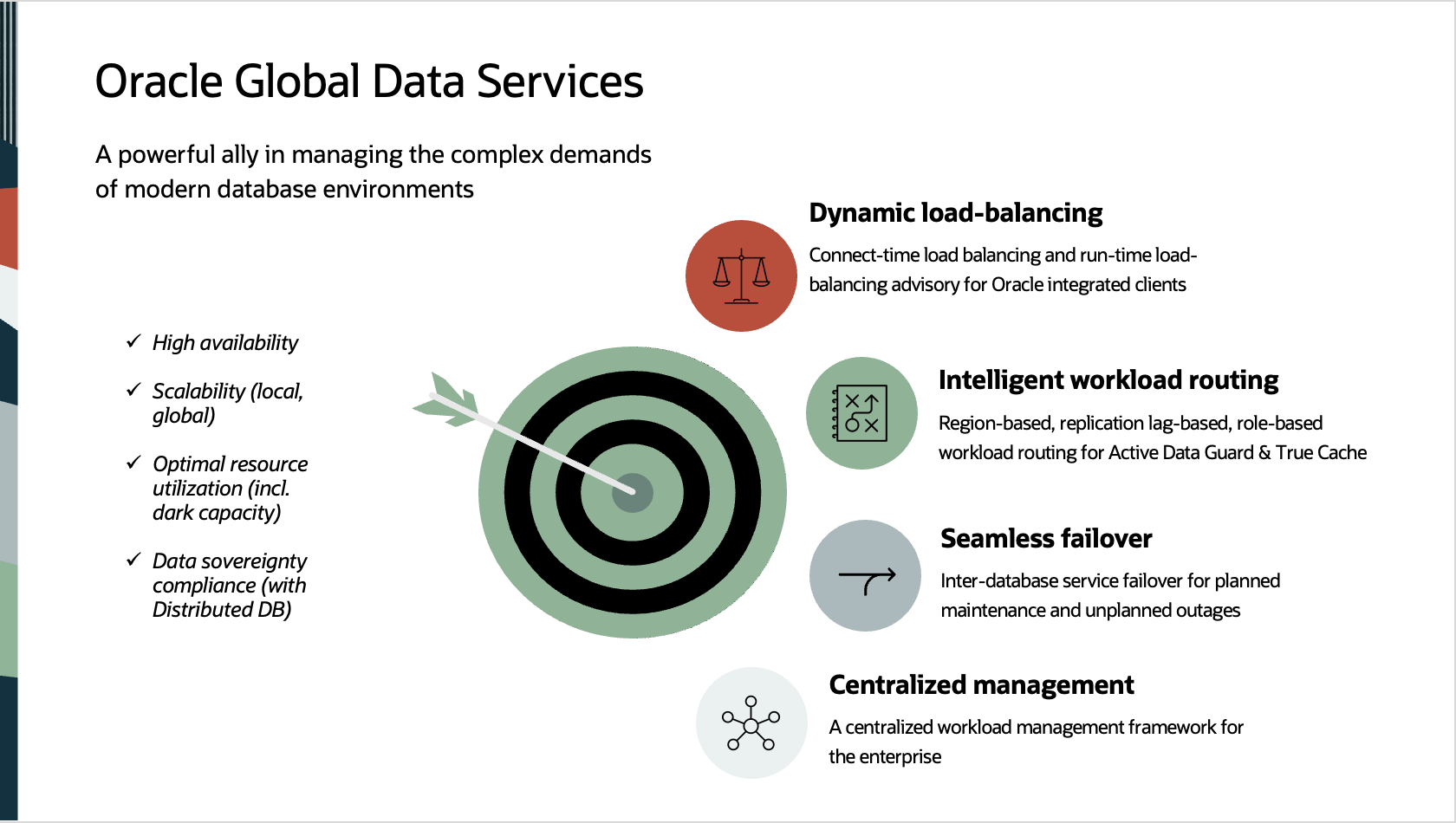Oracle Global Data Services (GDS) is a powerful solution designed to optimize workload performance and enhance database availability. It serves as a critical component in managing the complex demands of modern database environments, enabling organizations to achieve high availability, scalability, and optimal resource utilization.
Core Capabilities of Oracle GDS
Oracle GDS provides a comprehensive set of features to address the challenges of managing replicated and distributed database environments:
- Dynamic Load Balancing: GDS employs connect-time and run-time mechanisms to distribute workloads effectively across available resources. This ensures optimal utilization and prevents overload, guaranteeing consistent application performance.
- Intelligent Workload Routing: GDS intelligently routes workloads based on factors such as database role, geographic region, and replication lag. This capability allows organizations to tailor service placement and optimize resource usage based on specific application requirements and data access patterns.
- Seamless Failover: GDS automates inter-database service failover for both planned maintenance activities and unplanned outages. This ensures uninterrupted availability and minimizes downtime, providing a high degree of business continuity.
- Centralized Management: GDS provides a centralized framework for managing database services across the enterprise. This simplifies administration, streamlines operations, and reduces the complexity of managing replicated and distributed database environments.

Figure 1. Oracle GDS Core Capabilities
Dynamic Load Balancing for Maximizing Resource Utilization
GDS leverages both connect-time and run-time load balancing mechanisms to ensure optimal resource utilization. Connect-time load balancing distributes new connections based on the current capacity and load of each database instance. Run-time load balancing employs real-time advisories to dynamically adjust workloads, preventing overload and ensuring applications have consistent access to necessary resources. Additionally, GDS’s “Gravitation” process dynamically adjusts connections in response to changing conditions, further optimizing workload distribution and preventing performance bottlenecks.
Intelligent Workload Routing for Optimized Data Access
GDS offers intelligent workload routing capabilities, enabling organizations to tailor service placement based on database role, region, and replication lag.
- Role-Based Global Services: GDS allows for the configuration of database services based on specific database roles, such as primary, physical standby, logical standby, snapshot standby, and true cache. This enables organizations to define service placement policies that align with their specific needs and optimize resource utilization. For example, organizations can prioritize OLTP services on the primary database while directing analytical and reporting workloads to standby databases.
- Region-Based Workload Routing: GDS supports region-based routing, directing application connections to the nearest database replica. This minimizes network latency and improves performance for geographically distributed users.
- Lag-Based Workload Routing: GDS enables lag-based routing, allowing organizations to route read-only requests to standby databases based on their replication lag. This offloads read traffic from the primary database, improving overall system throughput while maintaining acceptable data currency for specific applications.
Inter-Database Service Failover for Uninterrupted Availability
GDS orchestrates inter-database service failover to ensure continuous availability during planned maintenance activities and unplanned disruptive events. In the event of a database failure, GDS automatically and transparently fails over services to a healthy replica, minimizing downtime and ensuring business continuity. This automated response eliminates human error and delays, ensuring minimal disruption to applications and end-users.
Centralized Service Management for Streamlined Administration
GDS provides a unified control plane for managing database services across the enterprise. The Oracle Global Data Services Control Utility (GDSCTL) offers a single interface for creating, configuring, operating, and troubleshooting data services across multiple databases. This centralized approach simplifies administration, reduces operational overhead, and accelerates service provisioning.
Conclusion
Oracle Global Data Services is an essential tool for managing and optimizing database services in today’s complex IT environments. Its comprehensive capabilities empower organizations to achieve high availability, maximize performance, and streamline administration. By leveraging GDS, businesses can ensure their critical applications remain operational and perform optimally, even in the face of growing data demands and dynamic business requirements.
For Oracle Global Data Services Best Practices 23ai, please see https://docs.oracle.com/en/database/oracle/oracle-database/23/haovw/oracle-global-data-services-best-practices.html
